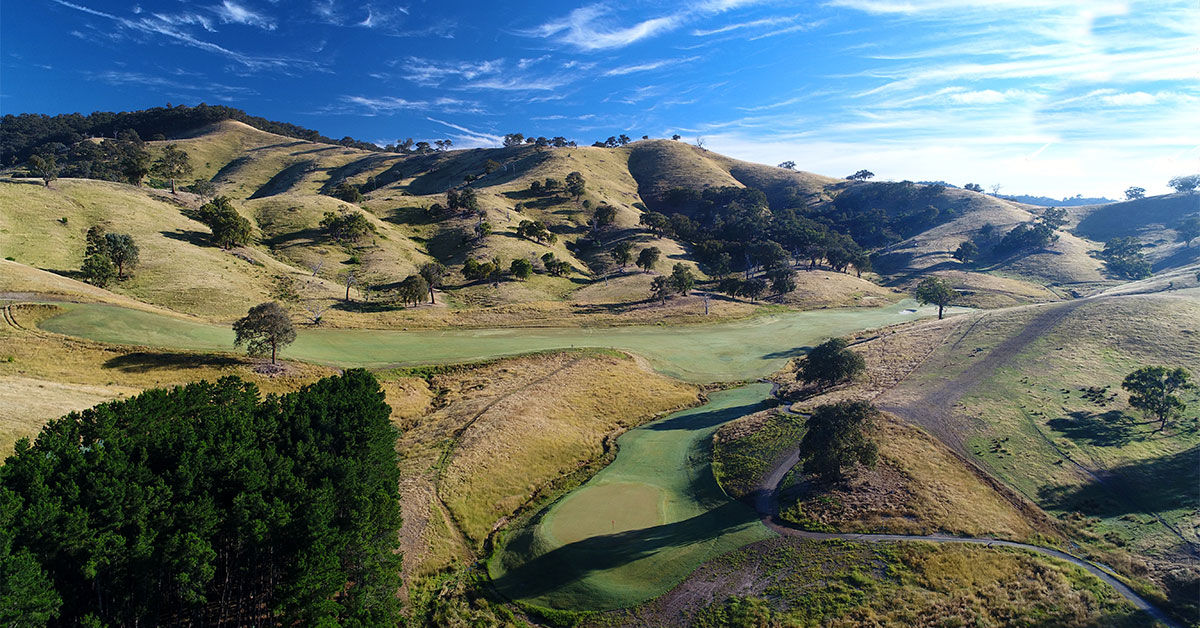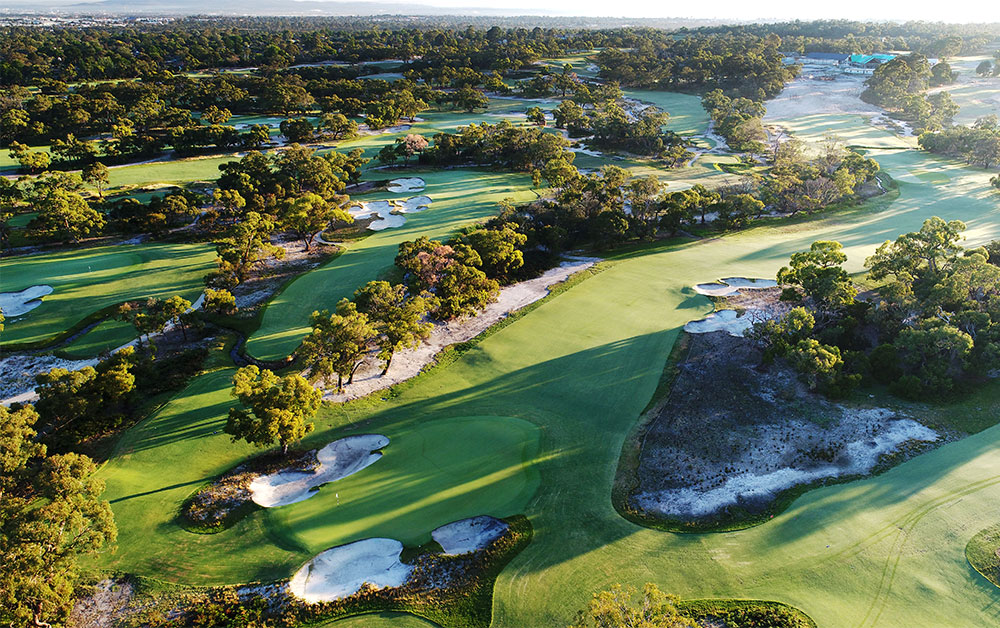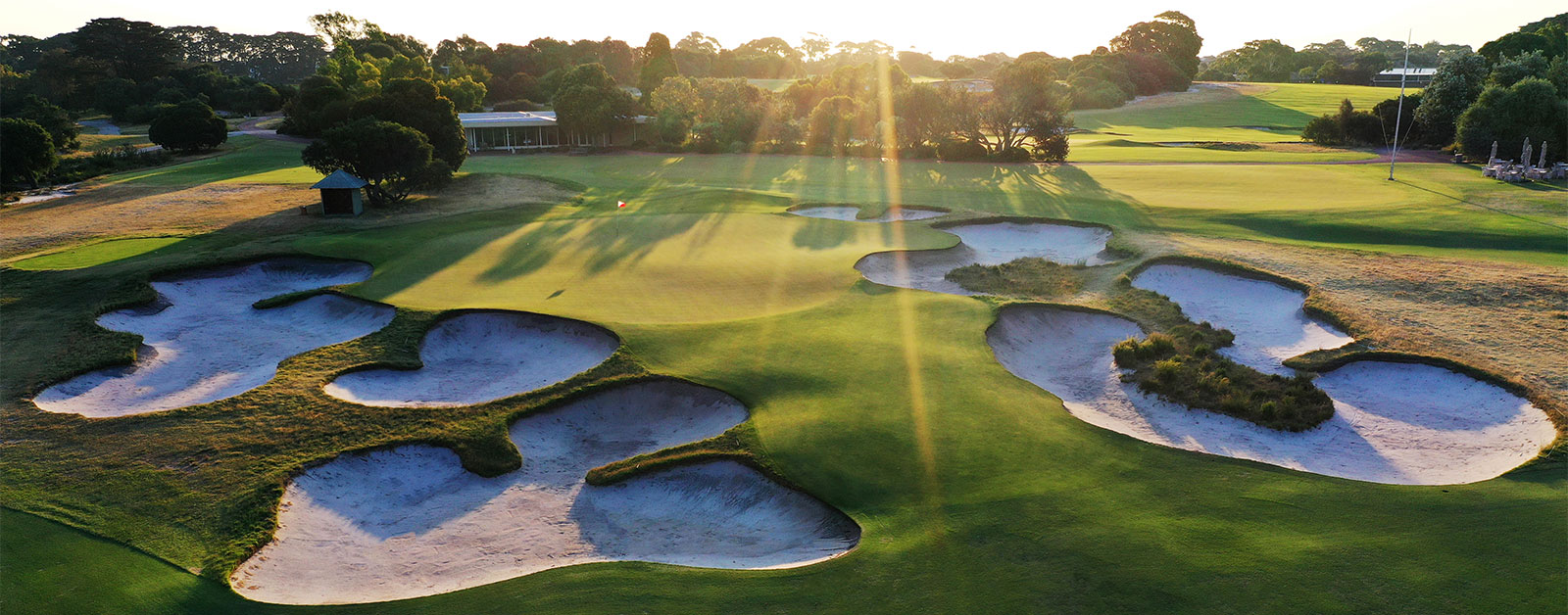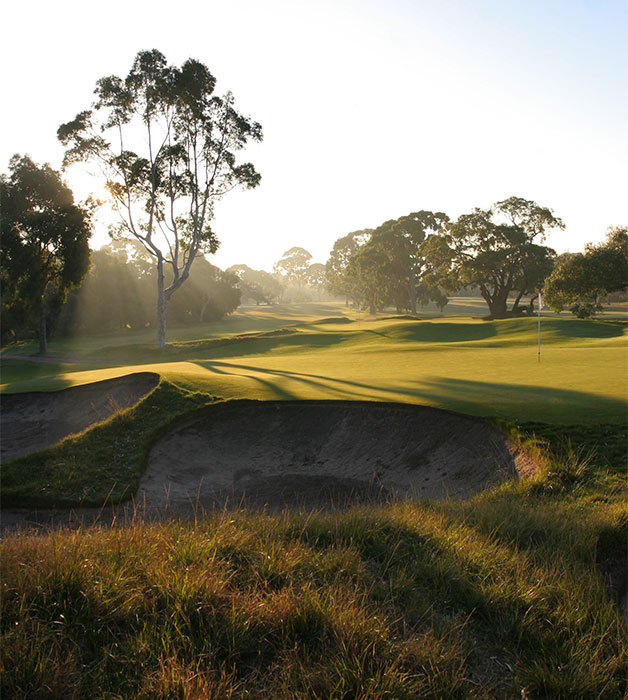Course photography by Gary Lisbon
With 33 layouts in Australia’s Top 100 Golf Courses, Victoria leaves other states in its wake when it comes to world-class fairways. But what makes the Garden State so great for golf, far beyond its famed Sandbelt region?
The Roaring Twenties spanning the decade of the 1920s was a period known for its artistic expression and cultural dynamism. It was the time of Art Deco, movie palaces, jazz music and the Charleston. For Melbourne the 1920s ushered in a golden age of golf-course construction. Golf courses were conceived at the eight lauded private clubs on the Melbourne Sandbelt during this period when the capital’s south-eastern outskirts underwent a golf construction boom.
It’s acknowledged that 1926 was pivotal to this golden age for that was the year legendary architect Alistair MacKenzie made a whistle-stop tour Down Under. The Scottish-born MacKenzie designed a new layout for Royal Melbourne Golf Club among his various site inspections. His interaction with Alex Russell and Mick Morcom was the catalyst for the boom that flourished through the 1930s until the opening of Huntingdale Golf Club in 1941.
Ten outstanding courses had their origins in this period: Royal Melbourne (East and West), Kingston Heath, Metropolitan, Commonwealth, Victoria, Yarra Yarra, Huntingdale and Peninsula Kingswood (North and South). Make that 13 with Woodlands, Spring Valley and The National’s Long Island, which aren’t formally part of the Sandbelt but should be by virtue of their quality and location.
A void exists on a golfer’s CV unless they have savoured the Melbourne Sandbelt, according to Daniel Andrews, Victoria’s staunchest of golf supporters. The Premier of Victoria says: “No one can call themselves a proper golfer until they’ve been down here and played these courses. Because there’s nothing like it anywhere else in the world.”
Much has been written about what makes the Sandbelt so special. Essentially, it’s a combination of factors according to Royal Melbourne superintendent Richard Forsyth. The architecture is a starting point along with the scale of how they built things with an eye for shaping. But it’s also the components to do with turf management, the climate and the soil type for which the Sandbelt gets its name.
The architecture is a starting point along with the scale of how they built things with an eye for shaping. But it’s also the components to do with turf management.
That rich vein of sandy loam subsoil beneath the playing surfaces of these courses provides the basis for great golf. Forsyth says: “This grey dune sand here
on the Sandbelt is quite unique – the way it can stand up vertically on a bunker edge, have a firm base to a bunker, but yet if you rake it at the bottom it stays [certain] to playing golf shots from.
“The characteristic of the sand gives that firmness, bounciness, and an ability to have those great bunker shapes and the dramatic edges. A lot of architects have come and studied it but if you haven’t got that characteristic sand it’s very hard to have that green [manicured turf] all the way to the bunker edge and then a sheer lip and have that stay stable.
“It also is really good for growing turf. It drains yet it stays firm because of its particle distribution, which is quite broad so it locks together quite well.”
It helps that Melbourne and Victoria are blessed with a year-round temperate climate for managing turf. A temperate climate is conducive to maintaining bentgrass greens, which are regarded as the best form of turf for putting surfaces and a better playing experience.
Forsyth says: “In terms of growing turf, Victoria’s pretty good because you can grow bentgrass. Once you go north of Sydney the humidity doesn’t allow you to grow bentgrass. So then you’re on couch greens, which never seem to rate as highly.”
Another quintessential element of Sandbelt golf is the juxtaposition of man-made architecture with native vegetation. Graeme Grant was instrumental with restoring native vegetation at Kingston Heath where he served as the long-time superintendent. Grant set a benchmark with the Heath’s landscaping practices that encouraged Sandbelt clubs and other courses to try and emulate.

Top sites, deep pockets and good design
But as Australian Golf Digest’s Top 100 illustrates, golf in Victoria goes well beyond 13 exceptional courses in Melbourne’s Bayside suburbs. In the modern era since 1996 – the year Tiger Woods turned professional – the entire state of Victoria has been transformed into a golf mecca.
Superb golf can be found in regional areas on all points of the compass [see panel below]. The Mornington Peninsula has emerged as a must-visit destination with 10 cracking courses. On the western side of Port Phillip Bay, Geelong and the Bellarine have four top-shelf courses. You’ll continue to find exceptional golf westward on the Great Ocean Road at Port Fairy, north to Black Bull on the Murray River, through to Cathedral Lodge up in the High Country and across to RACV Healesville and Eastern in the Yarra Valley.
Victoria has 18 regional courses ranked in this year’s Top 100, which is significantly more than those located in the regions of NSW (11), Queensland (six), WA (six) and SA (two). Three of Victoria’s regional gems were constructed in the Roaring Twenties – Barwon Heads (1920), Portsea (1925) and Sorrento (1929). However, 14 outstanding courses have been built during the Tiger era in what can only be described as a second golden age of golf-course construction.

It’s not by accident or sheer chance this has occurred. The proliferation of superb new courses can be attributed to three key factors: top sites, deep pockets and good design.
On the Mornington and Bellarina peninsulas a common ingredient among the very best courses is rolling terrain, which is ideal for golf. The sand dunes provide natural contours and sites for bunkers and green complexes. Along with a good type of sandy soil, not a lot of earth movement was required to create really interesting holes.
But over in the picturesque Yarra Valley, Eastern and RACV Healesville didn’t have the same attributes as they were built on a heavier clay base. What they did have was a developer/club with deep pockets to engage good architects (Greg Norman and Mike Clayton/Mike Cocking) and supply them with large budgets.
Sanctuary Lakes and Settlers Run are two more examples of what can be achieved by a top architect with the right tools and deep pockets. Sanctuary Lakes at Point Cook in Melbourne’s west is arguably the most successful residential golf development in Australia given its size (2,300 homesites). Norman and Bob Harrison provided developer LinksLiving with an exceptional course on what was an uninspiring piece of clay-based, flood-prone land. At another Norman/Harrison collaboration with a large budget, Settlers Run is the epicentre of a 500-lot community at Cranbourne in Melbourne’s south-east growth corridor developed by Medallist, with the backing of Macquarie Bank.
Collectively, with regard to course architects, Victoria can boast the most astute minds with the likes of the late Peter Thomson, Ross Perrett, Tony Cashmore, Mike Clayton, Mike Cocking, Ashley Mead and Darius Oliver leaving their mark on Australian courses.

Pioneering spirit and great foresight
Golf in Victoria would not be where it is today if not for the foresight of those early pioneers who secured large swathes of land to pursue the imported British game of golf. Likewise, the current state of golf wouldn’t be what it is if not for a number of influential men who had the vision and determination to bring about a second golden age of golf-course construction.
The current state of golf wouldn’t be what it is if not for a number of influential men who had the vision and determination to bring about a second golden age.
A figure that greatly influenced golf in Victoria was the late David Inglis. The co-founder of the Australian Masters was the driving force behind the formation of The National Golf Club on the Mornington Peninsula in the 1980s. Based on the American concept of transferrable membership shares, enough capital was raised from a share offering (starting from $6,000) to fund construction of an 18-hole layout by Robert Trent Jones Jnr (who also designed the adjoining RACV Cape Schanck). In 1999 The National released another 1,000 membership shares, raising $23 million to build two more courses – Moonah and Ocean (now Gunnamatta) – along with a $17 million clubhouse. The club has since grown to encompass 72 holes after a merger with Long Island Country Club at Frankston.
Just as influential has been entrepreneur Duncan Andrews who made his fortune establishing financial services company Australian Ratings (now Standard & Poor’s Australia). A chance visit to the struggling Dunes course in 1993 reminded Andrews of golf in Scotland and Ireland. He purchased the Mornington Peninsula course at auction for $1.23 million and gave eccentric Melbourne architect Tony Cashmore the licence to make something special. That he did and the public-access facility inspired a renaissance of links golf across Australia.
In 1999, Andrews turned his attention towards the Bellarine Peninsula where he invested in a 36-hole residential golf development at Thirteenth Beach. With layouts designed by Cashmore and Sir Nick Faldo, Thirteenth Beach has been a resounding commercial success. It has further enhanced its reputation internationally as the host of the Vic Open.
The success of The National, The Dunes and Thirteenth Beach encouraged others to purse their dreams. Moonah Links on the Mornington Peninsula was conceived about 2000 when Bill Leslie approached the Australian Golf Union (now Golf Australia) with a proposal to build a course on his cattle farm at Rye in an area known as ‘The Cups’. AGU chief executive Colin Phillips had expressed a desire to build a national training facility similar to Le Golf National near Paris. The AGU agreed to take a 25 percent stake in the project, which included two courses to be known as ‘The Home Of Australian Golf’. Golf Australia later sold its interest in the two-time Australian Open venue, however the Peppers-branded resort remains the state’s best play-and-stay offering.
That pioneering spirit appears to have been embraced by other visionaries. With the mantra ‘If you build it, he will come”, Golf Club Properties commissioned American Tom Doak to design St Andrews Beach as a links for public play in ‘The Cups’ region. While the original investors failed in their bid to create 36 holes with high-end accommodation, golfers continue to come and play a Mornington layout that remains an exhilarating experience.
At Yarrawonga on the Murray River, Jayral Developments identified Lake Mulwala as a unique backdrop for the Black Bull course designed by Thomson Perrett, which is the centrepiece of its Silverwoods residential estate.
Up in the High Country, investment banker David Evans built his own private American-style country club for family, friends and business associates. He asked Norman to design Cathedral Lodge through canyons and flowing creeks on the banks of the Goulburn River near Alexandra, two hours north-east of Melbourne.
It’s said ‘Success has a hundred fathers’. Such a statement is true when it comes to golf in Victoria. It’s not by accident or sheer chance that it’s become a mecca for golfers around the world. Top sites, deep pockets and good design along with a pioneering spirit and great foresight have delivered another golden age of golf-course construction.
 Friends In High Places
Friends In High Places
Premier of Victoria Daniel Andrews sees the value of golf far beyond the raw numbers and key performance indicators that politicians and bureaucrats are fond of quoting. Andrews sees golf as a vehicle to enrich the community.
After campaigning on a comprehensive golf policy at the 2018 Victorian state election, the Andrews Labor Government is delivering on its promise of improving golf facilities at both the top and bottom echelons of the game. At the professional level, the government is pouring in $12 million to the Vic Open during this election cycle to bolster a tournament that now enjoys sanctioning by the men’s European Tour and women’s LPGA Tour.
Elsewhere, government funding is behind construction of the new ‘Home of Golf’ at the former Sandringham golf course across the road from Royal Melbourne. And at a local level, dozens of clubs have received one-off grants to pursue much-needed improvements on and off the course. Total funding towards golf is almost $30 million over four years, which doesn’t include the extra millions that went into the successful staging of the 2019 Presidents Cup.
Victorians Top 100 Golf Courses By Region
Victorians are spoilt for choice when it comes to top-shelf golf. Here is a listing of where to find layouts ranked in Australian Golf Digest’s Top 100 Golf Courses. Due to recent renovations, Yarra Yarra and The National’s Gunnamatta layouts were ineligible for the 2020 ranking but are likely to appear in the front half of the 2022 ranking.
 Melbourne Sandbelt
Melbourne Sandbelt
1. Royal Melbourne (West)
3. Kingston Heath
6. Peninsula Kingswood (North)
8. Royal Melbourne (East)
9. Victoria
14. Metropolitan
20. Peninsula Kingswood (South)
30. Commonwealth
50. Huntingdale
* Yarra Yarra
Unofficial Sandbelt
27. Woodlands
54. The National (Long Island)
55. Spring Valley
Melbourne (outer south)
77. Cranbourne
79. Settlers Run
Melbourne (outer west)
90. Sanctuary Lakes
Mornington Peninsula
12. The National (Moonah)
16. The National (Old)
23. The Dunes
26. St Andrews Beach
41. Moonah Links (Legends)
45. Moonah Links (Open)
52. Portsea
60. Sorrento
75. RACV Cape Schanck
* The National (Gunnamatta)
Geelong & the Bellarine
24. Barwon Heads
32. Thirteenth Beach (Beach)
69. Curlewis
76. Thirteenth Beach (Creek)
High Country
17. Cathedral Lodge
Great Ocean Road
57. Port Fairy
Murray River
68. Black Bull
Yarra Valley & Dandenong Ranges
86. RACV Healesville
94. Eastern (South)
For more information on a Golfing Great head to Visit Victoria.
